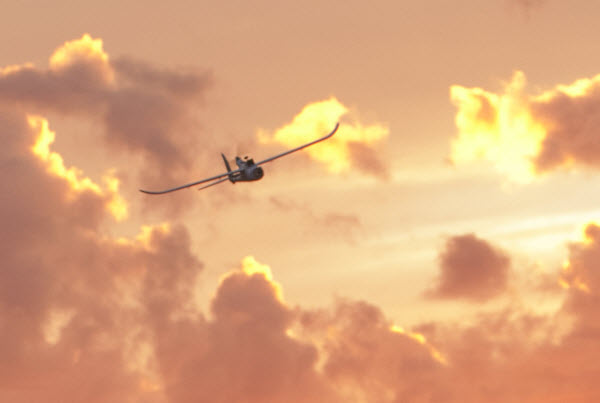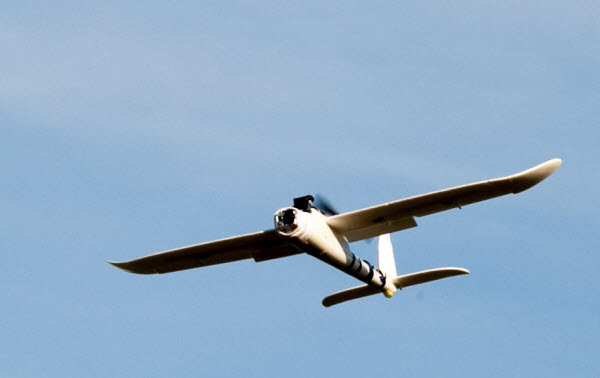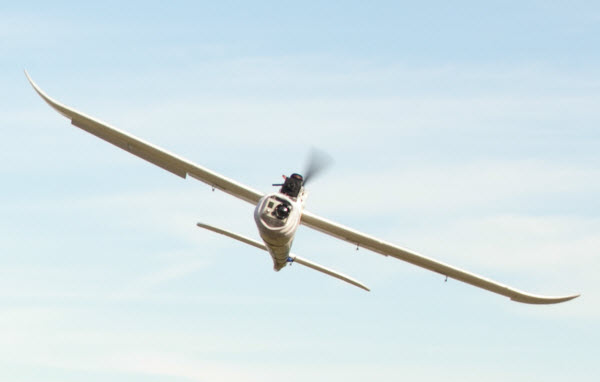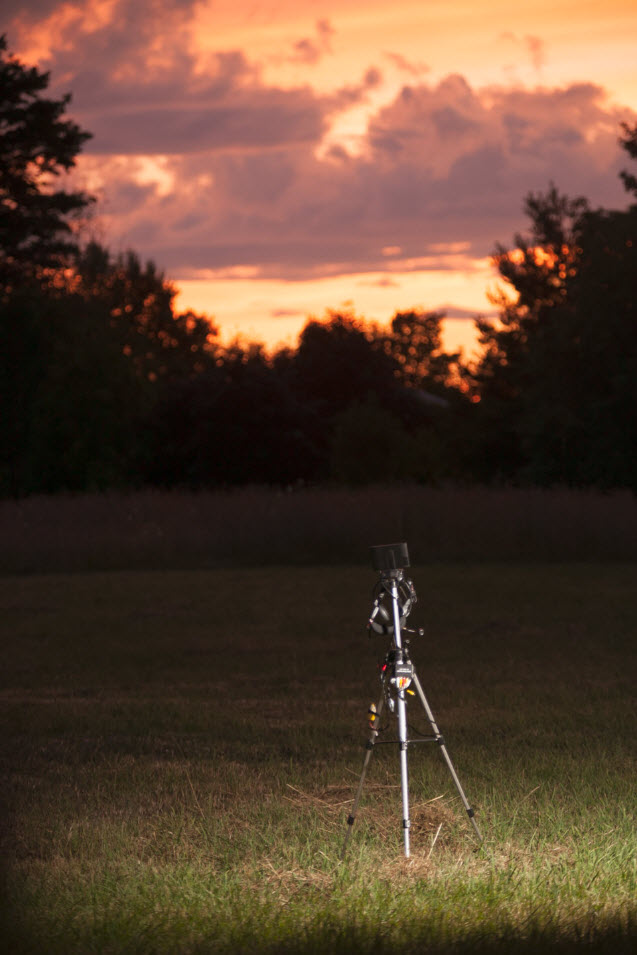Somewhere, be it high up in a tree or adrift in the waters of the great lakes, lay the proud remains of the Icarus. This fine machine had barely the chance to experience to wonders of flight; to soar above grassy fields and rolling waves, and to dance between the clouds. Barely time to stain its underside green from grass landings and see its journeys across the landscape reproduced in Google Earth from data stored in its on-board GPS logger. The Icarus was a young plane. And it died a young plane. This is its story.

Icarus’ final flight into the sunset.
A Noble Birth
Icarus was the spoiled first-born child of a doting parent. The plane’s construction was somewhat of a prolonged struggle between the desire to keep things simple for a first-time FPV build, and an urge to make things clean, sleek and fully functional. By the time the Bixler 2 kit was modified and assembled according to the specifications I had planned to incorporate, it had taken on a rather unique profile, featuring a blunted nose to carry the GoPro below the field of view of the secondary flight camera, numerous additional carbon fiber rods to reinforce the airframe, and a seemingly well thought out distribution of electronics and antennas, complete with internal wiring through the hollow tail to keep the fuselage looking sleek and free of excess wires and tape.

Icarus: the Bixler 2 retooled and perfected for FPV.
In hindsight, it may have been better to put a little less effort into a first plane, as the loss of a lesser machine would have been a much lighter blow to take. Nevertheless, the Icarus, named posthumously, was a marvel to behold, a joy to fly, and – all too soon – a devastating loss.
A Cacophony of Errors
From the start, this plane had some quirks. It’s maiden flight occurred only after three failed hand-launches, leading me to suspect that while technique could be blamed to an extent, the power, wing loading, and stall speeds of this modified Bixler 2 were close to their limits, despite the upgrades. Once in the air, though, things went smoothly the rest of the first day of flight tests. The only other major issue was the fogging lens of the GoPro, which was later remedied with desiccant inserts. The next day of flights went just as well, although in retrospect, this may have been the beginning of the serious errors that led to the loss of Icarus.
I had just moved to a new location, taking advantage of a long, paved stretch of seldom-traveled road leading to a wide clearing with visibility clear to the horizon 30 degrees to either side of where the road ended, and only a moderate amount of trees to worry about behind the launch spot. Water was present about 1/2 mile to the East and West, but didn’t seem close enough to be a concern – and shouldn’t have been. However, things went so well the first few flight, that by the second I was pushing several boundaries farther than was wise. Flying with 2.4GHz FrSky control (with telemetry) and 5.8GHz video, I expected about a mile of range, and didn’t intend to test my luck even that far. The video had been clear and free of interference or drop outs, and I was not getting any warning beeps from the telemetry – and so began the lulling to a false sense of security. Without an autopilot or even an OSD with RTH or RTL (Return to Home / Launch), there was very little that could be done in the event of signal failure. In fact, I don’t think I quite grasped at the time how vulnerable I was.

Things are going well… perhaps too well.
Other possible failures aside, the loss of reception from either of the two radios (control and video) meant almost certain doom. A control loss would engage the simple failsafe mode, which was configured to (hopefully) hold the controls in such a way to make the plane execute a lazy circle in the sky while waiting to re-establish a signal. There was also a fair amount of warning thanks to the FrSky telemetry-enabled receiver, which had three levels of beeps to indicate decreasing levels of signal strength: 1 (less than perfect reception). 2 (model is at far, but safe, range) and 3 (maximum range and imminent failsafe). Video was a bit more tricky. 5.8GHz video provides maximum resolution at the price of transmission range and object penetration. From my limited experience, it also features less of a gray-zone in terms of reception quality. When the video begins to get static, it is likely that it will soon cut out completely. Regardless, video was the weakest link in my design even if frequency was ignored. If you can’t see, you can’t fly – at least not for very long.
The Fateful Flight
The lapses in judgement discussed above were probably enough to eventually doom poor Icarus. I simply hurried its fate with the generous application of sheer stupidity. After a day of flying, I found myself at home with a troubling realization: I still had two sets of fully charged batteries. I had seen several videos of night flights with the same camera I was using, and while I was nowhere near ready to try that, I figured it wouldn’t hurt to take advantage of the last few hours of light, and test the highly-reputed Sony PZ0420 camera in the dimmer, evening skies.
The first flight went spectacularly. It was still bright out, and I finally had the anti-fog inserts for the GoPro, meaning that the footage I was recording would finally be usable for video-making. It was getting darker, but now we had a couple of bystanders waiting for an encore, and the sun was only just setting – there would be light for an hour still. And then the ground station died. It seems the batteries had been exhausted from earlier in the day, and there was no longer sufficient voltage to run the DVR. This didn’t directly interfere with my ability to fly the plane, as I was using my FatShark goggles with its own battery. However, the DVR signified a small but important insurance measure when it came to finding a lost plane. By recording the footage the plane was transmitting back to me, it would provide a way to review the last seconds before a crash or loss of signal, yielding valuable clues as to where it may have ended up. I decide to go ahead anyways. For better or worse, it probably wouldn’t have made a difference in this case.
The first few minutes were uneventful. I made some passes over my small audience, but then decided to gain some altitude to view the sunset. At this point, I estimate I was about 1/2 mile out (ground distance), but as high as 1,000-2,500 feet AGL. This was no higher than I’d been before, but for whatever reason, disaster chose to strike this time. I was flying level, and began to experience a trace amount of static. I turned away from the water, searching for my launch point. For the first time, though, I was lost. It didn’t matter – that realization came far too late. With almost no warning, the video cut out completely. I may have gotten a short glimpse of terrain a second or two later, but in little time, my ears were filled with telemetry warnings from the FrSky. Within 20 seconds from the first static – and less than 10 seconds from losing the video completely – I had also lost radio control. Whether it was just bad luck that both radios had maxed out their range at the same time, or if the plane was able to lose enough altitude in that 10-ish seconds to drop below line of sight, I’ll never know. I angled my antennas in vain and held my transmitter into the air, but the effort was futile. The plane was going down. Just where the Icarus cratered in is still a mystery. After hours of searching, first with transmitter and goggles on in hopes of picking up a signal, than with mere eyeballs and a prayer, I had to return empty-handed: Icarus was a total loss, GoPro and all.

Lonely ground station stands watch in vain hope of Icarus’ return.
NTSB Report: Pilot Error
I’ll save the NTSB their precious time in this investigation. This was a classic case of pilot error, the reasons of which I discussed in length above, and have summarized below:
- Failure to set strict “personal minimums” on range and altitude before sortie
- Failure to test failsafe mode to determine its actual effect in flight
- Failure to test and fully understand the margin of safety provided by telemetry, and how much time/range remained after hearing the first warning beeps vs the second or third.
- Failure to test the range and characteristics of the 5.8GHz video system to to an extent sufficient to understand how much time existed between static and full signal loss. Naive about “pushing through” the static.
- Never bow to the whims of bystanders.
- No DVR, No Fly.
- No RTH, No Fly (at least not beyond visual range).
- Spotter was not briefed to always be aware of where the plane was, and was not provided with binoculars.
- Underestimated the contrast / dynamic range issues associated with twilight lighting conditions.
- Did not fully understand the risk of flying near water at an altitude high enough that said water was well within gliding range.
- No plan for what to do in the seconds following signal loss – try to execute a slow climb with full throttle? Glide in a circle? Roll to expose a blocked antenna?
- Engineering flaws:
- Antenna blocked by battery – VTX was shielded by 5000mah of battery when plane was above the receiver rather than more lateral to it.
- No lost plane buzzer.
- Poor battery monitoring (no OSD – relied on audio and voltage buzzer).
Crash Reconstruction
As I already discussed, I have no video of the final moments. As FPV crashes go, however, my situation is hardly unique. In fact, it is quite common, regrettably. The nice thing about this is that I can provide a pretty representative depiction of what likely happened in the final seconds of that doomed flight:
Telemetry beeps: A Warning Unheeded
A Glimpse of Imminent Doom
http://youtu.be/1eYnYonElnw?t=1m00s
The Crash: What probably happened
http://youtu.be/iZCtuGIlng0?t=7s
Skywalker: A New Hope?
While the loss of the Icarus was truly tragic, its successor is already in the works. In short, it will be a larger airframe with a much more redundant control setup, and several emergency recovery features based on the lessons learned with Icarus. I’ll detail these in a later post, and hopefully have a video featuring some highlights captured with both Icarus and the yet-unnamed Skywalker up sometime this fall.
